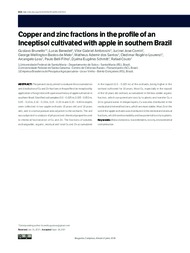Copper and zinc fractions in the profile of an Inceptisol cultivated with apple in southern Brazil.
Copper and zinc fractions in the profile of an Inceptisol cultivated with apple in southern Brazil.
Autoria: BRUNETTO, G.; BENEDET, L.; AMBROSINI, V. G.; COMIN, J. J.; MELO, G. W. B. de; SANTOS, M. A. dos; LOURENZI, C. R.; LOSS, A.; BELLI FILHO, P.; SCHMITT, D. E.; COUTO, R.
Resumo: The present study aimed to evaluate the accumulation and distribution of Cu and Zn fractions in the profile of an Inceptisol by application of fungicides with a previous history of apple cultivation in southern Brazil. Stratified soil samples (0.0 ? 0.025 m, 0.025 ?0.050 m, 0.05 ? 0.10 m, 0.10 ? 0.15 m, 0.15 ? 0.20 m and 0.20 ? 0.40 m depth) were collected in two apple orchards (8 years old and 18 years old), and in a native pasture area adjacent to the orchards. The soil was subjected to analysis of physical and chemical properties and to chemical fractionation of Cu and Zn. The fractions of soluble, exchangeable, organic, residual and total Cu and Zn accumulated in the topsoil (0.0 ? 0.025 m) of the orchards, being higher in the orchard cultivated for 18 years. Most Cu, especially in the topsoil of the 18 years old orchard, accumulated in the less stable organic fraction, which can potentiate toxicity to plants and transfer Cu e Zn to ground water. In deeper layers, Cu was also distributed in the residual and mineral fractions, which are more stable. Most Zn in the soil of the apple orchards was distributed in the mineral and residual fractions, which have low mobility and low potential toxicity to plants. Key words: Malus domestica, trace elements, toxicity, environmental contamination.
Ano de publicação: 2018
Tipo de publicação: Artigo de periódico
Unidade: Embrapa Uva e Vinho
Palavras-chave: Apples, Copper, Environmental contamination, Malus Domestica, Southern Brazil, Toxicity, Trace elements, Zinc
Observações
1 - Por padrão são exibidas publicações dos últimos 20 anos. Para encontrar publicações mais antigas, configure o filtro ano de publicação, colocando o ano a partir do qual você deseja encontrar publicações. O filtro está na coluna da esquerda na busca acima.
2 - Para ler algumas publicações da Embrapa (apenas as que estão em formato ePub), é necessário ter, no celular ou computador, um desses softwares gratuitos. Sistemas Android: Google Play Livros; IOS: iBooks; Windows e Linux: software Calibre.
Acesse outras publicações
Acesse a Base de Dados da Pesquisa Agropecuária (BDPA) para consultar o acervo completo das bibliotecas da Embrapa.

